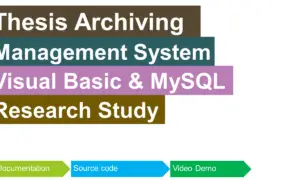Data Archiving Information System Review of Related Literature
REVIEW OF RELATED LITERATURE/SYSTEMS
This capstone project cited books, articles and related systems, which are relevant to the related study. It is composed of related literature and studies which contain facts and information significant on the design and development of the data archiving information system.
REVIEW OF RELATED LITERATURE
The Evolution of Data Archiving
According to Ortiz (2009) over the last few years there has been an increasing amount of interest in data archiving. Factors such as the explosive growth of data quantities on corporate networks along with the need to retain more and more of this data for longer periods in order to meet various legal and corporate governance requirements, and the need to reduce costs wherever possible, are driving this growing interest. Along with this growing interest the evolution of data archiving that has now culminated in Cloud Based Archive Solutions. The most common method of achieving this goal is through the process of archiving, which, unlike backups, moves inactive data from primary disk-based storage to an easily accessible, less expensive secondary storage tier then deleting it from the disk source locations. This can help realize the objective of cutting costs by freeing up expensive primary storage, reducing backup windows thereby increasing operational efficiency and providing reliable protection of the data for the long term. A viable and effective data archive should provide: scalability, cost effectiveness, availability, and secure long term protection for the data.
(http://www.storage-switzerland.com)

Data Archiving
According to Rouge (2010) data archiving is the process of moving data that is no longer actively used to a separate data storage device for long-term retention. Data archives consist of older data that is still important and necessary for future reference, as well as data that must be retained for regulatory compliance. Data archives are indexed and have search capabilities so that files and parts of files can be easily located and retrieved. Data archives are often confused with data backups, which are copies of data. Data backups are used to restore data in case it is corrupted or destroyed. In contrast, data archives protect older information that is not needed for everyday operations but may occasionally need to be accessed.
(http://searchdatabackup.techtarget.com/definition/data-archiving)
Benefits of Data Archiving
Archiving is one of the best ways to manage uncontrollable data growth because it will help you identify which files are no longer active within your organization and, thus, not required on your primary storage tier. The requirements of your data (value to the organization, speed of access, security, etc.) will change over time so both the media and location of this data should also change to more cost effectively meet those requirements. Archiving software helps you achieve this.
(http://www.bridgeheadsoftware.com/solutions/benefits_of_data_archiving/)
Automated Data Archiving
Data archiving is essential for organizations that accumulate new information but still need to retain older information. The trends of corporate and agency policy, legal precedent, and government law and regulation are for longer retention, more information, and faster retrieval. Automated data archiving helps organizations to achieve these capabilities at lower costs.
(http://www.emc.com/corporate/glossary/data-archiving.htm)
REVIEW OF RELATED STUDY
Database Archiving for Long-Term Data Retention
According to Craig S. Mullins (2006), organizations are generating and keeping a more data now than at any time in history before. This is so for many reasons. First of all, the amount of data in general is growing. According to industry analysts, enterprise databases are growing at the rate of 125% annually. Even more interesting is that as much as 80% of the information in those databases is not actively used (in other words, it is ready for archiving). Data may need to be retained for both internal and external reasons. Internal reasons are driven by company needs. If an organization business requires the data to conduct business and make money then that data will be retained. Today’s modern organizations are storing more data for longer periods of time for many internal reasons. Typically, data is stored longer than it used to be to enable analytical processes to be conducted on the data. Data warehousing, data mining, OLAP, and similar technologies have delivered more and better techniques for extracting information out of data. So businesses are inclined to keep the data around for longer periods of time. But external reasons, typically driven by the mandate to comply with legal and governmental regulations are another significant factor driving the need to store more data.
http://www.tdan.com/view-articles/4591
Open Archival Information System
An Open Archival Information System (or OAIS) according to Wikipedia.org (2013) is an archive, consisting of an organization of people and systems, that has accepted the responsibility to preserve information and make it available for a Designated Community. The term OAIS also refers, by extension, to the ISO OAIS Reference Model for an OAIS. The information being maintained has been deemed to need “long term preservation”, even if the OAIS itself is not permanent. “Long term” is long enough to be concerned with the impacts of changing technologies, including support for new media and data formats, or with a changing user community. “Long term” may extend indefinitely. OAIS archive must abide by: Negotiate for and accept appropriate information from information Producers; the community should be able to understand the information without needing the assistance of the experts who produced the information; Make the preserved information available to the Designated Community.
(http://en.wikipedia.org/wiki/Open_Archival_Information_System)
Archive Information System
The Archive Information System (AS) is an SAP data archiving environment-integrated generic tool for indexing data archives. The indexes that are created, called the Archive Information Structure, let you display the archived data. The archive information structure includes the following components: Archive Retrieval Configurator (ARC)-The ARC enables you to create archive information structures with the help of field catalogs, and to fill the structures with data from the archive. The archive information structure, which represents a kind of archive index, provides the basis for archive data reporting; and Archive Explorer-The Archive Explorer enables fast searches of archived data. It does this by accessing the archive information structures that have been created and stored in transparent database tables using the Archive Retrieval Configurator. Furthermore, the Archive Explorer allows direct accesses of individual data objects in the archive, which can then be displayed in both technical and application-specific views.
(http://help.sap.com/saphelp_nw73/helpdata/en/4d/8c77cb910b154ee10000000a42189e/content.htm)
You may visit our Facebook page for more information, inquiries, and comments. Please subscribe also to our YouTube Channel to receive free capstone projects resources and computer programming tutorials.
Hire our team to do the project.


